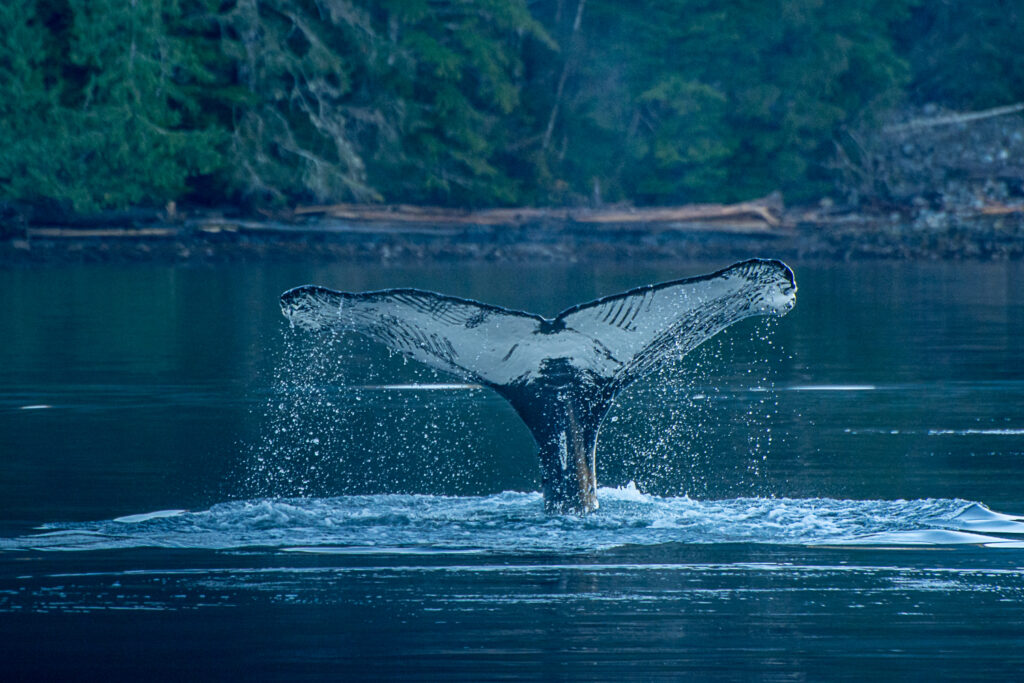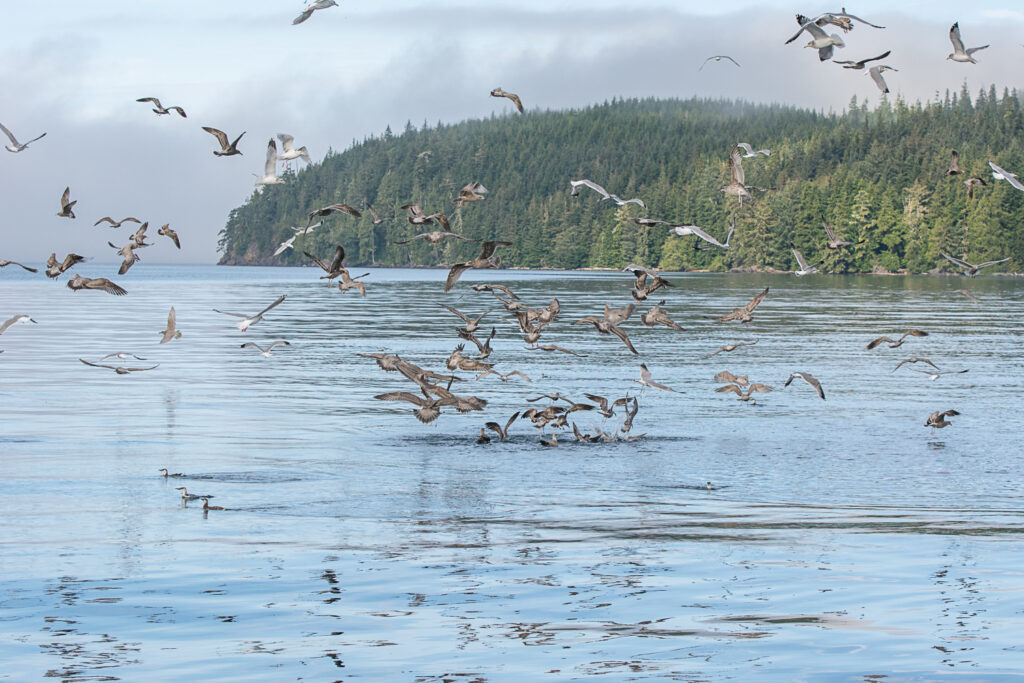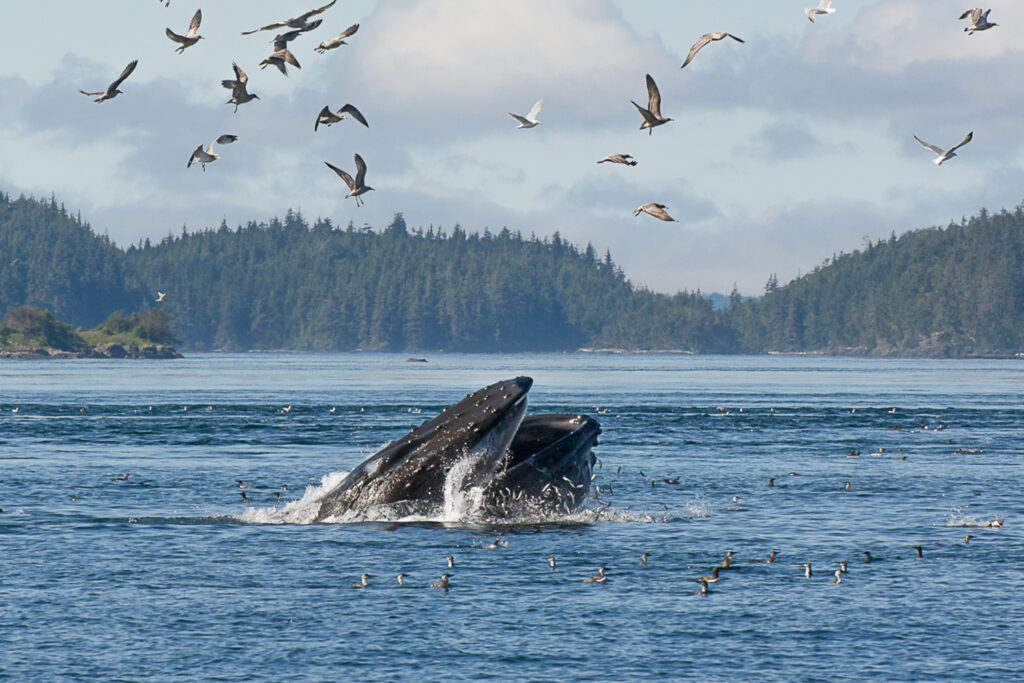I’ve been working as a whale watching captain and naturalist for over a decade in British Columbia, but mostly focusing my energy in the Northeast Vancouver Island region. I’ve spent hundreds of days in the Johnstone Strait and Broughton Archipelago area taking travelers out to see the abundance of marine life found in those waters. On a typical day we could have encounters with Killer Whales, Stellar’s Sea Lions, Pacific White-Sided Dolphins, Dall’s Porpoise, and you guessed it Humpback Whales. I’ve spent countless hours with Humpback Whales lunge feeding all around my boat. This is a cooperative feeding initiative between the diving birds like Common Murres and Rhinoceros Auklets, the scavengers like Glaucous Winged Gulls and Bald Eagles, and the enormous Humpback Whales.

As schools of small forage fish move through the turbulent tidal waters of the area the first player to begin the hunt is the Common Murres. While floating around an active feeding area if there is low activity the birds are usually extremely loud. Their guttural “aaarrrrrrrr” calls somewhat comedic as they bellow their awkward asynchronous chorus across the water. I am often alerted to feeding activity when the murres go silent and then disappear, diving deep. The murres use their specially adapted wings to hastily propel themselves deep down and below the forage fish. They begin to attack the forage fish, which bunch up into a tight swirling ball, as is there nature to do when attacked. Survival in numbers. As the murres become more numerous and more aggressive, the ball of forage fish quickly looks for their escape route. To go down, left, right, forward, or backward means swimming into the mouths of dozens of hungry birds. The only path that is open is directly overhead. The ball of forage fish rises in the water column until it’s bubbling at the surface. The fish try dillegently to escape their beaked pursuers but have no where left to go.

This is when the next signal is sent. The forage fish, trying desperately to escape their underwater pursuers and are flailing helplessly at the surface of the water. Their silvery scales and splashing sounds alert their next predators: the airborne type. Gulls and eagles then swirl around, splashing head first into the pile of squirming fish, the gulls hope to get a mouthful to fly away with. The spectacle can be seen from over a kilometer away as hundreds of birds swirl around like a tornado over top of the struggling fish. It is noisy, chaotic, and incredible amazing to see in person. Every so often a Bald Eagle will fly down into the fray, pushing the gulls away, and drive their sharp talons into the ball of fish. A successful eagle will fly off with two talons full of wriggling fish.
The diving birds and the airborne birds have made the Humpback Whales job quite easy now. Weighing up to 45 tons and growing to a length of nearly 45 feet, these whales can devour over 1500 pounds of food in a single day. They are baleen whales and so they rely on lots of small food sources versus one large animal. Krill and small fish are their main food sources. They open their huge mouths wide, allowing water and food in, shut it closed and use their large and strong tongue to push the excess water through the baleen plates. This process removes the excess water and leaves behind their meal. It’s a pretty smooth system and allows them to save energy on hunting while still getting enough calories to survive and flourish. The baleen whales are considered to be more advanced evolutionary than toothed whales because of this low-energy expenditure hunting and high calorie intake. It is what has enabled them to become such large animals.

The Humpback Whales are highly aware of these balls of forage fish being pushed together by the birds. Humpbacks have “tubercles”, or tiny hairs that are inside of fatty bumps on their heads. It is thought that these tubercles might be an advanced form of vibration detection allowing them to sense when a ball of fish is forming. However, it is currently unconfirmed how the humpbacks know that a ball of forage fish has formed. Regardless, the whales tune into the activity and point themselves straight at the ball of fish and travel directly for it. When they get within a few hundred yards they take a big breath and a deeper dive, moving themselves directly below the fish. Once the whale has disappeared, I can estimate it’s only a few seconds until the humpback reappears. What happens next is truly a spectacle of nature. The gulls and eagles all go completely silent, flying directly upwards and somewhat dispersing from where they had been chaotically attacking the boiling ball of forage fish. They can see something in the water we can’t see from the boat. In an instant, the humpback whale launches itself half out of the water with it’s mouth wide open from underneath the ball of fish. In seconds, the thousands of forage fish have found a new home inside the cavernous mouth of the humpback. As the humpback slips back down into the water, you can see and hear the water being pushed out of its mouth as it strains the fish with it’s baleen. The whale will then take a couple of breaths in the same spot as it processes it’s meal.

The ball of forage fish is no longer. Some of the gulls and eagles disperse in all directions looking for their next meal opportunity while some gulls sit on the water nearby digesting their meal. The true sign that the feeding frenzy and forage fish are gone from the area is when the Common Murres return to the surface and begin chattering and socializing again. Those comedic guttural calls signalling the end of the extraordinary feeding event.
